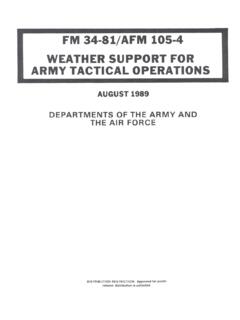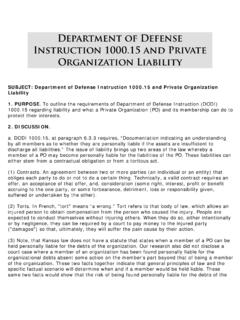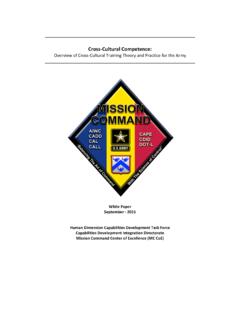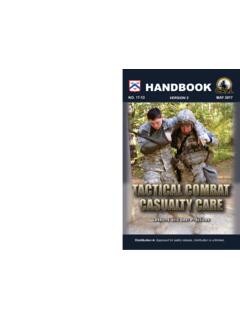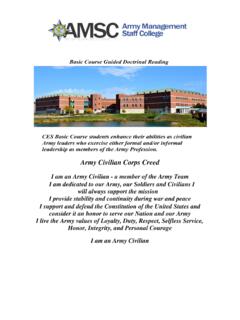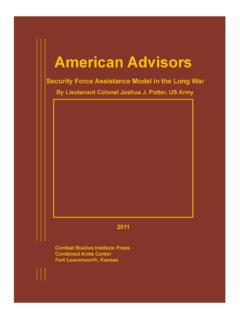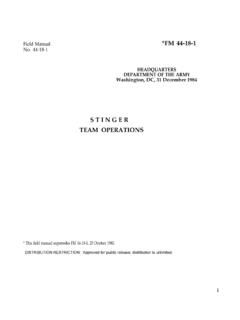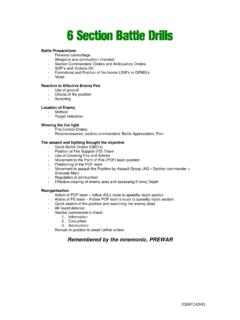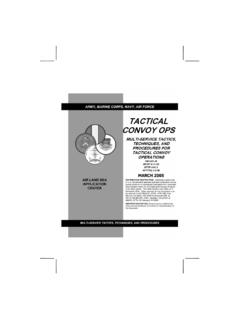Transcription of Combat Trains Command Post (CTCP) Operations
1 Combat Trains Command Post (CTCP) Operations CPT Andrew Cairns/CPT Jacob Dellinger Support for reconnaissance Operations is the inherent responsibility of the Combat Trains Command post (CTCP). The CTCP is charged with maintaining the momentum of the operation through supporting the maneuver plan. The squadron s success is contingent on a CTCPs ability to resource and maintain the squadron s three reconnaissance troops through a task organization inclusive of logistical, administrative, and maintenance functions. The squadron s ability to conduct sustained reconnaissance and security Operations was heavily reliant on the ability for the tactical logistics execution to adequately support the maneuver plan. During 5th Squadron 4th Cavalry s most recent rotational experience at the National Training Center (NTC), it experienced widespread success through the implementation of a sound reconnaissance and surveillance (R&S) plan supported by a thorough sustainment plan.
2 The link between the execution of the sustainment by the forward support company (FSC) and the maneuver troops was the CTCP led by the headquarters and headquarters troop (HHT) commander with support from the squadron s logistics and personnel officers. This article will provide a way to approach the preparation of a CTCP to include training, manning and equipping to enable the squadron to have depth in mission Command , maximize the logistical common operating picture and sustain Operations . The most critical aspect of the preparation of the CTCP was the identification of the routine Operations required to successfully employ the CTCP and execute sustainment Operations . The squadron was offered a fantastic opportunity to identify the routine with a training density occurring in the summer of 2014.
3 Prior to 5-4 CAV s deployment to NTC 15-06, the squadron deployed to Fort McCoy, WI in support of the Exportable Combat Training Capability (XCTC) rotation. The mission allowed the squadron to train all aspects of the armored reconnaissance fight, to include implementing the CTCP in support of the unit s sustainment Operations . During this exercise, the CTCP included the squadron S-1 and S-4 sections, the HHT headquarters section , and elements of the FSC maintenance platoon. The CTCP was controlled by the HHT commander in conjunction with the S-1 and S-4. The following is the task organization of the Combat Trains : Figure 1-2, Task Organization of the Combat Trains Figure 1-1, Elements of HHT completing break down of CTCP at Fort McCoy, WI Approved for Public Release Distribution UnlimitedTo ensure that the Combat Trains would be capable of supporting the squadron, intensive rehearsal of the battle drills was conducted and that became the main focus of the troop.
4 The longest and most complex drill that required multiple rehearsals was displacement of the CTCP. This drill consisted of tearing down the Standardized Integrated Command Post System (SICPS) and preparing the Command track (M1068) for movement while simultaneously maintaining communication with squadron HQs and receiving reports from the troops. The most important lesson from conducting multiple iterations was that tear down and set up of the OE-254 antenna significantly slowed down movement. Without losing capability, the CTCP modified its communication design to where the Quick Erect Antenna Mast System (QEAMS) was used for the brigade administrative/logistics (A/L) net since this frequency needed to reach the furthest (was not used at XCTC) and a COM201 was emplaced on top of the M1068 for talking to the forward troops.
5 Other key battle drills rehearsed included battle tracking, owning the fight when the Command post (CP) met its displacement criteria, and receiving and transmitting Combat reports via frequency modulation (FM) and Joint Capabilities Release (JCR). The preparation of the CTCP continued when the squadron redeployed to Fort Riley. The CTCP was able to maintain tempo in its development through the execution of several validation exercises leading up to the NTC rotation. The squadron utilized home station training opportunities at both the unit level and installation schools to enhance the capability of the CTCP. Entering into this training density, there was a clear focus on digital reporting which helped shape the training regimen. The focus would later pay significant dividends during the training rotation due to the depth of knowledge amongst the Troopers in both the CP and the CTCP.
6 The NTC offered the squadron an opportunity to put stress on systems, validate training focuses, and prepare for future Operations . A pivotal component of the CTCP was the ability to receive, process and act on information which was reported by the troops. The emphasis on digital systems and long range communications prior to the deployment enabled the CTCP to be successful. During the execution of Operations , the squadron would leverage the JCR system, specifically, the chat feature, to assist in the execution of logistics synchronization (LOGSYNC) meetings with the troops during Operations . The JCR log provides a window for an open dialogue over JCR or a chat room to aid in reporting and cut down on flash, immediate, priority, routine (FIPR) backlog; preventing reports from being lost.
7 Rapid and accurate reporting endured during the mission as a result of employment of this system. Additionally, the S1 section would focus heavily on the employment of open office within JCR to provide the troops a standardized and accurate reporting tool for statuses (STATs) throughout Operations . This technique would pay dividends during sustained Operations over stretched lines of communications. Furthermore, the S1 was able to use the Microsoft Excel and Word features on JCR log for reporting of personnel statuses (PERSTATs) and tracking of casualties and equipment. The troop 1 SGs reported their daily losses from the previous day s battle period to maximize situational awareness for the squadron headquarters and would allow for more responsive soldier regeneration.
8 The chat room created shared understanding for all troops during critical battle rhythm events. JCR quickly Approved for Public Release Distribution Unlimitedbecame the primary means of communication due to the distances troops were located from the CTCP and CP throughout the operation. In terms of providing depth of mission Command nodes for the squadron, the CTCP stood prepared to assume control of the fight throughout the battle. This was completed largely in part due to adhering to doctrine and understanding of communication platforms. The Combat Trains attempted to replicate all the systems, digital and analog, to provide the squadron with an alternate and sometimes a tertiary Command post. The CTCP was able to do this by maintaining doctrinal distance to the CP of 1-4 kilometers (KM) to ensure that it was not removed from the fight.
9 Due to the squadron s integration of high frequency (HF) radios and JCR, it was able to maintain communication via multiple platforms during Operations stretched over 30KM. The squadron s depth in communication platforms and thorough primary, alternate, contingency, emergency (PACE) plan made it so that the distance maintained between the CTCP and CP was not a major factor for mission Command purpose, but it did allow for a mutually supportive relationship between the two nodes. The distance of the CTCP in relation to the CP became increasingly important as vehicles at the CP experienced mechanical problems as well as improper forecasting for fuel where the distance allowed for rapid response to the CP from the CTCP. Since the CTCP included the unit maintenance collection point (UMCP) during the rotation, it was difficult to displace and the Command team had to tie into the micro-terrain to ensure survivability during the mission.
10 The lack of ideal terrain to house an element ranging from 20- 30 vehicles made finding suitable positions within doctrinal distance difficult and proved to be a daunting challenge throughout the rotation. While it was a challenge to conduct reconnaissance (RECON) ahead of displacement and secure the CTCP, it was not impossible. Since all elements of the CTCP were aware of delineated responsibilities, the Command team was able to focus on security and reconnaissance for the CTCP during Operations . However, there were instances when prudent risk was taken and security was reduced (based on intelligence) to allow for the headquarters elements to conduct movement preparations. Much of the focus for the troop commander was on conducting both map/mounted reconnaissance ahead of displacement.
